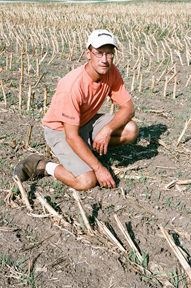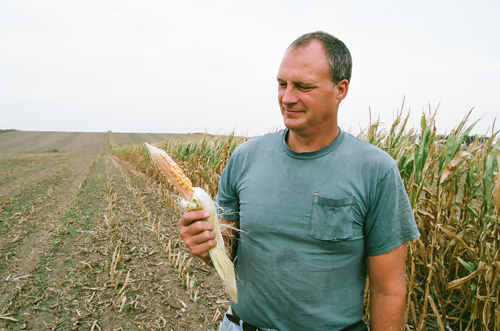by Paul Queck, freelance writer based in Indianapolis, Ind.
J and Allan Schanbacher have never planted oats any time but early spring. But this year they planted 63 acres in mid-August as they scramble to make up for drought-ravaged hay and corn crops.
The Schanbachers hope that a few timely fall rains and an average-to-later frost will produce an oat hay or oatlage crop on 63 acres of ground that they cut corn silage on in mid-August. "We could use that hay for our replacement heifers," says J. "We don't have a lot to lose. If it doesn't work out, we can just consider the oats an inexpensive cover crop."
The Schanbachers milk around 200 cows on their farm near Atkins in eastern Iowa. The drought was severe in that area. "We received only around 3.5 inches of rain from Memorial Day to the end of August," says J.

Oats were already up and growing in late August on J and Allan Schanbacher's farm near Atkins, Iowa. The Schanbachers hope to get an oat hay or oatlage crop this fall to help make up for poor corn and hay crops from the drought.
"With the early spring and a first cutting in April we had a chance for six cuttings of hay this year," says J. "But with the drought we will only end up with five and a shortage of hay. The third cutting was just 75 percent of normal and the fourth and fifth were just half a crop each. We're already buying hay and it's expensive."
The Schanbachers plant enough corn that in a normal year they have dry corn to sell after making corn silage and storing dry corn for the needs of their dairy operation. "This year I doubt we'll have any extra cash corn to sell," says J. "We had to cut 40 percent more corn acres than we had planned to get the silage we will need. And we expect our dry corn will take a yield hit of at least 25 percent."
J and Allan Schanbacher have never planted oats any time but early spring. But this year they planted 63 acres in mid-August as they scramble to make up for drought-ravaged hay and corn crops.
The Schanbachers hope that a few timely fall rains and an average-to-later frost will produce an oat hay or oatlage crop on 63 acres of ground that they cut corn silage on in mid-August. "We could use that hay for our replacement heifers," says J. "We don't have a lot to lose. If it doesn't work out, we can just consider the oats an inexpensive cover crop."
The Schanbachers milk around 200 cows on their farm near Atkins in eastern Iowa. The drought was severe in that area. "We received only around 3.5 inches of rain from Memorial Day to the end of August," says J.

Oats were already up and growing in late August on J and Allan Schanbacher's farm near Atkins, Iowa. The Schanbachers hope to get an oat hay or oatlage crop this fall to help make up for poor corn and hay crops from the drought.
"With the early spring and a first cutting in April we had a chance for six cuttings of hay this year," says J. "But with the drought we will only end up with five and a shortage of hay. The third cutting was just 75 percent of normal and the fourth and fifth were just half a crop each. We're already buying hay and it's expensive."
The Schanbachers plant enough corn that in a normal year they have dry corn to sell after making corn silage and storing dry corn for the needs of their dairy operation. "This year I doubt we'll have any extra cash corn to sell," says J. "We had to cut 40 percent more corn acres than we had planned to get the silage we will need. And we expect our dry corn will take a yield hit of at least 25 percent."
J got the idea for a fall oat crop from a local dairy nutritionist and then from various tweets and from a video with Illinois extension dairy specialist Mike Hutjens. J's corn was ready to cut for silage almost a month earlier than normal, giving him an early enough planting window to make a fall oat crop possible. A rain a few days before seeding and one that followed a few days after drilling had the oats up and growing the third week of August.
The Schanbachers' neighbor, Dennis Haerther of rural Atkins, Iowa, has also seeded a fall oat crop on corn ground chopped early in August for silage. "The corn in that field had very few ears," says Haerther. He received permission from the insurance company to cut all but a few check rows for silage and sold the silage to a nearby dairy farmer for growing replacement heifers.

Dennis Haerther, Atkins, Iowa, holds one of the few ears of corn this field produced due to the drought. This field was cut in early August for silage for replacement heifers, and seeded with oats for a fall oat hay crop.
Haerther hopes to be able to sell a crop of oat hay or haylage off the land. Like Schanbacher, a timely August rain after seeding has the oats up and growing.
The Schanbachers' neighbor, Dennis Haerther of rural Atkins, Iowa, has also seeded a fall oat crop on corn ground chopped early in August for silage. "The corn in that field had very few ears," says Haerther. He received permission from the insurance company to cut all but a few check rows for silage and sold the silage to a nearby dairy farmer for growing replacement heifers.

Dennis Haerther, Atkins, Iowa, holds one of the few ears of corn this field produced due to the drought. This field was cut in early August for silage for replacement heifers, and seeded with oats for a fall oat hay crop.
Haerther hopes to be able to sell a crop of oat hay or haylage off the land. Like Schanbacher, a timely August rain after seeding has the oats up and growing.





